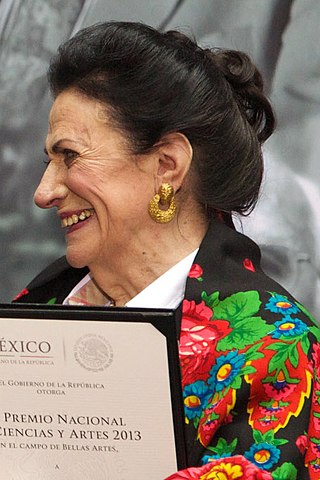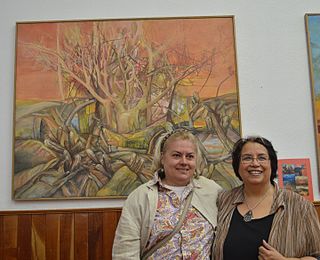
Elizabeth Catlett, born as Alice Elizabeth Catlett, also known as Elizabeth Catlett Mora was an American and Mexican sculptor and graphic artist best known for her depictions of the Black-American experience in the 20th century, which often focused on the female experience. She was born and raised in Washington, D.C., to parents working in education, and was the grandchild of formerly enslaved people. It was difficult for a black woman at this time to pursue a career as a working artist. Catlett devoted much of her career to teaching. However, a fellowship awarded to her in 1946 allowed her to travel to Mexico City, where she settled and worked with the Taller de Gráfica Popular for twenty years and became head of the sculpture department for the Escuela Nacional de Artes Plásticas. In the 1950s, her main means of artistic expression shifted from print to sculpture, though she never gave up the former.

Ángela Gurría Davó was a Mexican sculptor. In 1974, she became the first female member of the Academia de Artes. She is best known for her monumental sculptures such as Señal, an eighteen-meter tall work created for the 1968 Summer Olympics. She lived and worked in Mexico City.

Mariana Yampolsky was a Mexican-American photographer. A significant figure in 20th-century Mexican photography, she specialized in capturing photos of common people in everyday situations in the rural areas of the country. She was born in the United States, but came to Mexico to study art and never left, becoming a Mexican citizen in 1958. Her career in photography began as a sideline to document travels and work in the arts and politics, but she began showing her photography in the 1960s. From then until her death in 2002, her work was exhibited internationally receiving awards and other recognition both during her lifetime and posthumously.

Geles Cabrera Alvarado is a Mexico City sculptor who has worked in a variety of materials, there is a museum dedicated to her work in the south of the city.

María Luisa Reid is a Mexican artist from Zacatepec in the state of Morelos. She is a member of the Salón de la Plástica Mexicana.

Tosia Malamud was a Mexican sculptor of Ukrainian origin, one of the first female graduates of Mexico's Escuela Nacional de Artes Plásticas. Her family immigrated to Mexico when she was four, and her talent for art appeared early. She went to art college against her parents' wishes, graduating in 1943. Because of family obligations, her career did not begin until the mid-1950s with two important exhibitions that brought her style to the attention of critics. From then until her death, she exhibited her work in Mexico and abroad. She also created large and small works for public spaces and was considered to be the best bust maker in Mexico at the time. In addition to depictions of notable people, she created works mostly dealing with maternity, family and childhood which can be found in places such as the Museo de Arte Moderno and the Hospital Siglo XXI in Mexico City. La familia has become iconic for Mexico's Instituto Mexicano de Seguro Social and Viento for the Museo de Arte Contemporáneo in Morelia.

Deyanira África González Melo is a Mexican sculptor who generally works in ceramics, depicting elements of the human form, especially the torso, generally with mutilations and other disturbing elements to dispute the otherwise traditional and sensual depictions of the human body. She has exhibited her work since studying at the Escuela Nacional de Artes Plásticas (ENAP) in Mexico as well as in Europe and the Caribbean. Her work has received recognition in Mexico and abroad, and is a member of the Salón de la Plástica Mexicana.
Ofelia Márquez Huitzil is a Mexican artist and member of the Salón de la Plástica Mexicana. She is best known for her abstract art with figurative elements, which has made her work somewhat controversial and excluded from Mexico abstract art movement.
Rosa Castillo Santiago was a Mexican sculptor, and founding member of the Salón de la Plástica Mexicana.
Olga Dondé was a Mexican artist involved in various fields but best known her still life pieces. She was a self-taught painter, who worked for two years until she decided to enter works in a show in 1968. From then she had about 100 showings of her work, including more than forty individual exhibitions in Mexico, the United States, South Americana and Europe. She also founded artistic organizations, an art gallery and a publishing house. Dondé’s work was recognized by admission in the Salón de la Plástica Mexicana, among other honors and her work continues to be shown and honored after her death.

Herlinda Sánchez Laurel was a Mexican artist and art professor at the Universidad Nacional Autónoma de México. Her career has been recognized by membership in the Salón de la Plástica Mexicana, and awards from the state of Baja California, the Palacio de Bellas Artes and the International Coordination of Women in Art among others.

Naomi Siegmann was an American artist who developed her career in Mexico, and was noted for her depiction of everyday objects outside their normal contexts. She began her career after she moved to Mexico with her family, learning to carve wood. She worked in this medium for about twenty years, before moving on to other materials, including recycled ones, in part due to her concerns for the environment. During her career, she had solo exhibits in Mexico and the United States, with participation in collective exhibits in these countries and Europe. She has been commissioned to create monumental works in Mexico and the United States. Her work has been recognized through membership in the Salón de la Plástica Mexicana.

Silvia Barbescu is a Romanian multi-disciplinary artist who has been developing her career in Mexico since 2000, after being invited to the country by the Mexican government. Preferring to work with mixed media and mixed techniques, with images based on nature, her work has been recognized by various awards as well as membership in the Salón de la Plástica Mexicana and the Sistema Nacional de Creadores de Arte in Mexico.
Rocio Caballero is a Mexican figurative painter, whose works often depict mythical worlds and are noted for her use of symbolism. Her work has been exhibited individually and collectively in Mexico, the United States, South America and Europe and can be found in collections such as that of the National Museum of Mexican Art. Her work has been recognized with membership in the Salón de la Plástica Mexicana.
Susana Campos is a Mexican artist whose work tends to be complex compositions in various media generally introspective or commentary on society. She has had over thirty five individual exhibitions in Mexico and participated in various collective exhibitions in Mexico and abroad. Her work has been recognized with membership in the Salón de la Plástica Mexicana since 1966, and has been written about by various noted art writers in Mexico.
Laura Elenes (1933–2005) was a Mexican painter, sculptor and print maker. whose work was recognized with membership in the Salón de la Plástica Mexicana and several tributes in Mexico and other countries after her death.
Patricia Mejía Contreras was a Mexican sculptor and graphic artist whose work was recognized with membership in the Salón de la Plástica Mexicana.
Flor Minor is a Mexican sculptor and graphic artist, known for bronze sculptures and graphic work that generally depict the male form. Her works often are based on the concept of balance or lack thereof. Minor has had individual exhibitions in notable venues in Mexico and abroad, and her work can be found in a number of public and private collections. She has been recognized in Mexico with membership in the Salón de la Plástica Mexicana.
Virginia Morales is a Mexican photographer and member of the Salón de la Plástica Mexicana.
Noemí Ramírez is a Mexican visual artist, whose work has been recognized with several honors including membership in the Salón de la Plástica Mexicana.









